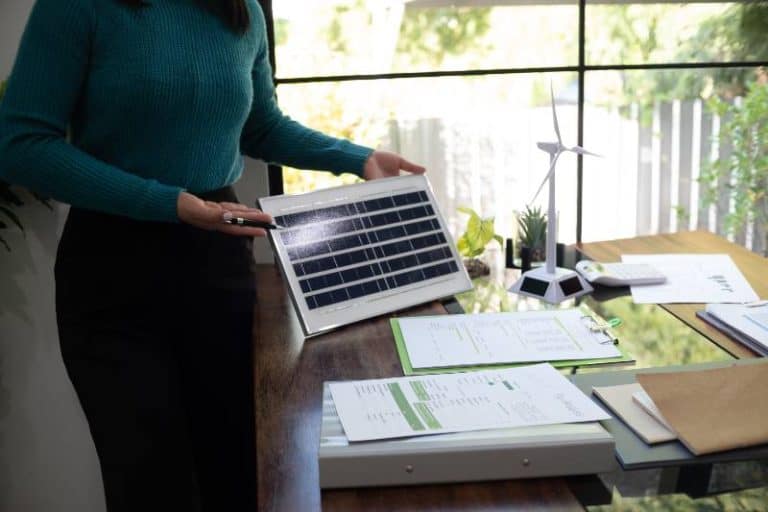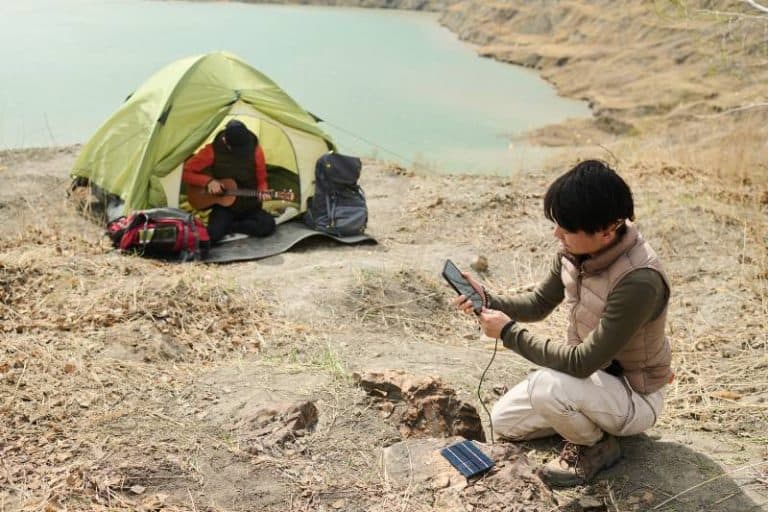Can You Take Portable Solar Panels on a Plane? [Your Guide]
In 2010, the cost of solar electricity was about $0.76 per kilowatt-hour. Fast forward to 2020, and the price has dropped to just $0.09 per kilowatt-hour. That’s an 89% decrease in just 10 years! An increasing number of people are making the switch to solar energy. But a lot of people are getting curious, can you take portable solar panels on a plane? In this article, we will answer that question and give you a guide to taking portable solar panels on a plane!
The components of your portable solar power kit are authorized for domestic and international destinations; however, they cannot be loaded together in the same bag. Your solar panels can be folded and kept either in your carry-on or checked-in luggage.
Key Takeaways
- According to the International Air Transport Association (IATA), portable panels are considered battery-powered devices and must be only carried in carry-on bags.
- These battery-operated items shouldn’t be packed in checked luggage since they run the risk of getting damaged or catching fire there.
- They suggest packing a lithium battery for inspection in order to prevent accidental damage.

What are the Federal Aviation Authorities guidelines on portable solar panels?
Lithium batteries are ubiquitous in solar chargers because they are rechargeable. This is made possible by a process where lithium ions flow in one direction to release electrons to provide power, and then the ion flow is reversed to recharge the battery. Lithium batteries have several advantages over other types of batteries, including a higher energy density and a lower self-discharge rate.
As a result, they can hold more charge and retain it for longer periods. In addition, lithium batteries are not prone to the “memory effect”, which can reduce the capacity of other types of batteries over time. For all these reasons, lithium batteries are the preferred choice for solar chargers.
This method, however, makes these sorts of batteries prone to catching fire if they are damaged.
As a result, the Federal Aviation Administration (FAA) recommends:
- Avoid placing these batteries-powered devices in checked luggage, where they are more likely to be damaged and catch fire. They advise that if a lithium battery must be checked, it must be packed so that it is not harmed by accident.
- Uninstalled lithium batteries (those not contained within a gadget) are not permitted in checked bags and must be taken in a carry-on bag.
- Any broken or defective batteries, which may appear obvious at this time, should not be transported on the airline in any luggage.
- Lithium-ion batteries with capacities larger than 100-watt hours (Wh) per battery are not allowed in checked luggage.
Does my solar charger have a battery?
As we mentioned before, some solar chargers have a battery, and the solar panel charges a lithium battery, which can subsequently power other electronic devices through USB.
Some solar chargers, on the other hand, merely charge devices via USB and do not store any of the energy generated in batteries.
This distinction is significant because there are no restrictions on transporting solar panels on an aircraft (apart from the size, which must fit in luggage!).
If your portable solar charger contains a lithium-ion battery and the battery is installed in the device, you are allowed to bring it in your carry-on and checked baggage.
You are also allowed to bring up to two spare lithium-ion batteries, as long as they meet the 100-watt-hours (Wh) limit described above. These extra batteries must be individually shielded to prevent short circuits. The best way to do this is by placing each spare battery in its plastic bag or protective pouch.
You are not allowed to bring lithium-ion batteries that are not installed in a device. This includes spare batteries, as well as loose lithium-ion cells and batteries.
Additionally, If you have a portable solar charger with a lead acid battery, you are allowed to bring it on board an aircraft, as well as up to two spare lead acid batteries. But, these batteries must be individually protected to prevent short circuits, and the best way to accomplish this is to put each battery in its plastic bag or insulated case.
Which rules apply to my solar charger?
Now that you know the difference between portable solar chargers with and without batteries, as well as the restrictions on lithium-ion batteries, you can determine which rules apply to your particular solar charger.
If your charger has a battery:
- The battery must be installed in the device.
- You are allowed to bring up to two spare batteries, as long as they meet the 100-watt-hours (Wh) limit.
- To prevent short circuits, each battery must be individually safeguarded.
If your charger does not have a battery:
- You are allowed to bring the charger in your carry-on and checked baggage.
Carry on or checked baggage?
According to the International Air Transport Association (IATA), portable panels are considered battery-powered devices and must be only carried in carry-on bags.
Examples of solar chargers that can be taken on a plane
Renogy Solar Bluetooth Speaker
There are several solar chargers on the market that are small and lightweight enough to be taken on a plane. The Renogy Solar Bluetooth Speaker and Charger is one such option. This charger is not only capable of charging your phone or other electronic devices via its USB ports, but it also doubles as a Bluetooth speaker. With a 5,000 mAh capacity, the Renogy charger is within the range of what is allowed on a plane. Additionally, it boasts great sound quality and provides up to 10 hours of power.
RAVPower 15,000 mAh charger
There are many different types of solar chargers on the market, but not all of them are created equal. When choosing a solar charger for air travel, it is important to consider factors such as output power, portability, and compatibility. The RAVPower 15,000mAh charger is a great option for those looking for a powerful and portable charger.
This charger offers three USB outputs, allowing you to charge multiple devices at the same time. Additionally, the RAVPower 15,000mAh charger is dustproof and shockproof, making it ideal for use in rugged environments.

Do Planes Limit The mAh A Solar Charger Can Have Onboard?
As a general rule, any power bank over 100Wh cannot be taken on a plane without prior approval. Even with prior approval, the power bank must not exceed 160Wh; this is for the safety of all passengers and crew.
A milliampere hour (mAh) is a unit of measurement that is commonly used to describe the energy charge that a battery will hold. It is equal to a thousandth of an ampere hour (Ah). Both metrics are often used to represent how much energy a battery can hold and how long a gadget can run before it has to be recharged. The term “mAh” is often used about batteries, as it provides a more accurate estimate of a battery’s true capacity. In general, the higher the mAh rating, the longer the battery will last before needing to be recharged.
Watt hours measure the number of watts that a battery can provide in an hour. This is not very useful when you are trying to choose a battery as a consumer, but it can be helpful when comparing different types of batteries.
What Does Wh = mAh x V / 1,000 Mean?
Wh = mAh x V / 1,000 means that the energy in watt-hours is equal to the charge in milliamp-hours times the voltage, then divided by 1,000. You can use this equation to convert the charge used by a battery into watt-hours.
For example, if you have a battery that is 8,000 mAh at 1.5 V, you would multiply those numbers together to get 12,000. Then, you would divide that number by 1,000 to get 12 Wh. This equation is a quick and easy way to convert the charge into energy so that you can more easily compare different types of batteries.
Portable solar panels on a plane FAQs
How to tell if a solar charger is over 100Wh
The majority of solar chargers on the market are under 100Wh. However, some high-end models may exceed this limit. If you are unsure whether or not your solar charger is over 100Wh, you can check the product specifications or contact the manufacturer.
Most solar chargers on the market are well under 100 watt-hours, which is the maximum allowed for lithium-ion batteries in carry-on luggage by the FAA. But there are a few that exceed this limit, so it’s important to know how to calculate watt hours before you travel.
The equation is simple: just divide the milliamp hours (mAh) by 1000, and then multiply that number by 3.7. This will give you the nominal voltage of the battery, which is typically around 3.7 volts in lithium-ion batteries.
For example, if you have a solar charger with a 30,000mAh battery, you would calculate it like this: 30,000/1000 x 3.7 = 111wH.
As you can see, this particular charger exceeds the 100-watt hour limit, so you would need to get authorization from your airline before traveling with it. Most airlines have an online form that you can fill out in advance, so it’s always best to check before you pack your bags.
Can I take a solar backpack on a plane?
Solar backpacks are a great way to charge your devices while on the go, but you may be wondering if they are allowed on airplanes. The answer is yes, as long as the backpack meets the same restrictions as other portable solar chargers.
This means that the backpack must have a battery that is under 100 watt-hours, and the backpack itself must be small enough to fit in your carry-on luggage. If you are unsure whether or not your solar backpack meets these requirements, you can check the product specifications or contact the manufacturer.
Can You Charge A Solar Charger With A Plane’s Built-in USB Port?
Solar chargers are a great way to keep your devices charged while on the go, but can you charge a solar charger with a plane’s built-in USB port? The answer is, that it depends. If your solar charger has a battery pack, you may be able to connect the battery to the plane’s USB port. However, if you only rely on sunlight to charge your device, without a battery pack, it likely won’t work. It’s also important to check that your charger’s battery is compatible with the USB charger you’re using. If you’re not sure, it’s always best to consult with a professional before using any type of adapter or converter.
Conclusion
Portable solar panels are a great way to stay powered up while you’re on the go, and with a little bit of preparation, you can take them with you on your next international and domestic flights. We hope this guide has helped you understand the process of flying with solar panels and given you the information you need to make your trip a success!






